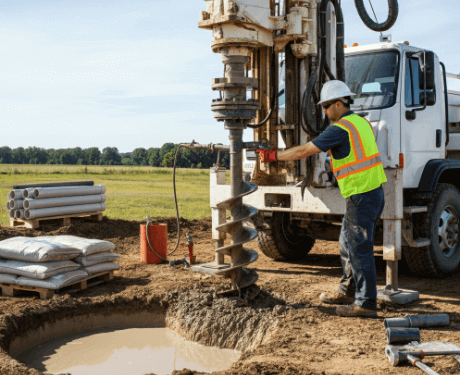How deep do you need to drill a well to get water? If you’re thinking about buying land or building a home in a rural part of the U.S., this is one of the most important questions to ask. Across the United States, the average well depth for residential use ranges from 100 to 400 feet; however, in some areas, wells may need to be as deep as 1,000 feet to reach a reliable water source. Factors such as local geology, water demand, and seasonal changes can all impact the depth required for drilling. Renowned real estate investors Steve Daria and Joleigh, who specialize in buying land for cash, stress the importance of knowing this before investing in any property. They’ve helped countless buyers avoid unexpected drilling costs by assessing water access early in the buying process. So, how deep do you need to drill a well to get water? It depends on your location, but it’s a vital detail when planning any land purchase. Book a free discussion today to get expert advice and make informed decisions about your land project!
Key Points
- Typical Well Depth Varies Widely: While many residential wells in the U.S. are between 200 and 400 feet deep, the actual depth can range from as shallow as 100 feet to over 800 feet. This variation depends heavily on your location and the specific characteristics of your land.
- Geology and Aquifer Levels are Key Factors: The depth required to reach a reliable water source is determined by local geology, the water table level, and the specific aquifer that needs to be tapped into. Factors such as high elevation or recent drought conditions may require drilling significantly deeper to ensure a consistent supply.
- Deeper Wells Often Mean Better Water: Drilling deeper can lead to cleaner, more reliable water because it bypasses surface contaminants and taps into more stable underground sources. This can also provide better protection against seasonal fluctuations that affect shallower wells.
- Costs Depend on More Than Just Depth: Drilling is typically priced per foot, but your total cost also includes materials like well casing, the pump system, and necessary permits. A deeper well requires more materials and a more powerful pump, which increases the overall project expense.
- Planning Ahead Saves Time and Money: Before drilling, research public well logs for your area, consult with neighbors about their well depths, and always hire a licensed driller. Getting professional advice and conducting a hydrogeological survey can help you accurately estimate depth and budget accordingly.
What is a water well, and how does it work?
A water well is a private, engineered structure designed to access groundwater stored in natural underground layers of sand and rock, known as aquifers.
The process begins by drilling a borehole deep into the earth until a sufficient water-bearing formation is reached.
A durable casing is then installed to prevent the borehole from collapsing, with a screen at the bottom to filter out sediment while allowing water to enter.

To protect the water from surface contaminants, the space around the casing is sealed with grout.
Inside the well, a submersible electric pump pushes water up to a pressure tank in your home, which maintains consistent water pressure at your faucets.
The question of “How deep do you need to drill a well to get water?” depends entirely on your local geology and the depth of these aquifers.
Once operational, professionals measure its flow rate and water levels to ensure it provides a reliable supply.
Finally, regular water testing and routine maintenance are essential to guarantee your well water remains safe and the system functions properly for years to come.
Get Started: Get Your Cash Offer Below…
We are direct land buyers. There are no commissions or fees and no obligation whatsoever. Start below by sharing where your property is and where we can send your offer…
What are the main factors that determine how deep a well needs to be?
Several key factors determine the depth of a well, making it a site-specific question rather than a one-size-fits-all answer.
Your local geology is the most significant variable, as drilling through hard rock requires more effort than drilling through soft sand to reach an aquifer.
The depth of the underground water table, which can fluctuate seasonally, and the specific aquifer you aim to tap into are also critical.
Your property’s elevation and topography play a role, as higher ground often requires deeper drilling to reach the same water source as a lower-lying property.
The ultimate answer to “How deep do you need to drill a well to get water?” is also influenced by water quality goals, as deeper wells can bypass surface contaminants.
Setback rules from septic systems and property lines, mandated by local permits, can also dictate the drilling location and necessary depth.
While deeper wells provide a more stable supply, they are more expensive and may require a stronger pump.
The best approach is to review public well logs for your area and consult a licensed driller for an accurate estimate.
How does drilling depth impact the overall cost of a new well?
- Deeper Wells Mean Higher Drilling Costs: The deeper the well, the more labor, time, and equipment it takes to drill, which increases the total cost. Deeper drilling also requires more materials, such as casing and piping.
- Depth Affects How Much You’ll Pay Per Foot: The price per foot usually increases as you go deeper, especially if the ground is rocky or hard to drill through. That’s why asking “How deep do you need to drill a well to get water?” is so important before starting.
- Pump and Equipment Needs Change With Depth: Deeper wells often need stronger, more expensive pumps to bring water to the surface. This adds to both the installation and long-term maintenance costs.
- More Depth Can Mean Cleaner Water—but Not Always: Many people ask, “How deep do you need to drill a well to get water?” thinking deeper means safer water. While it can reduce surface contamination, deeper isn’t always better depending on local conditions.
- Deeper Wells May Require More Permits or Testing: In some states, wells that exceed certain depths may require additional inspections, water quality tests, or special permits. These extra steps can add time and money to your project.

Can a well be too shallow? What are the risks?
Yes, a well can absolutely be too shallow, which introduces significant risks to both water availability and quality.
Shallow wells pull water from near-surface aquifers, which can easily be affected by seasonal changes in water levels and may dry up completely during droughts.
They also face a much higher risk of contamination from surface runoff containing fertilizers, pesticides, or bacteria from nearby septic systems.
This vulnerability means the water can become cloudy with sediment, especially after heavy rain, leading to issues with taste, odor, and color.
Answering “How deep do you need to drill a well to get water?” is critical because shallow wells often have lower flow rates and may require more frequent maintenance or filtration.
While deeper wells cost more to drill and pump, their access to more stable, protected water sources often justifies the investment.
If your well struggles to keep up or shows changes in quality, you should test the water regularly and consult a licensed driller.
Ultimately, a properly drilled well provides a safer and more reliable water supply for your household.
How long does the process of drilling and completing a well usually take?
- Site Evaluation and Permitting (1–2 weeks): Before drilling commences, the site must be inspected, and permits must be obtained and approved by local authorities. This can take anywhere from a few days to two weeks, depending on your location.
- Determining Well Depth (1–3 days): Contractors will review the land and local water table to determine the optimal depth for drilling a well to access water. This step is quick but essential, as it influences equipment and cost.
- Drilling the Well (1–5 days): The drilling time depends on the soil conditions and the final depth. Shallow wells can be drilled in just a day, while deeper wells may take several days.
- Installation of Pump and System (1–2 days): Once you determine the required drilling depth for a well to access water, the proper pump system is installed. This typically takes one to two days.
- Water Testing and Final Checks (2–5 days): After drilling, the water is tested for safety, and the system is inspected. This ensures your new well is ready for use.
What kind of maintenance does a well require?
A private water well requires regular maintenance to ensure it consistently delivers safe and reliable water for your household.
At a minimum, you should have your water tested annually for bacteria, nitrates, and pH levels to catch any potential health risks early.
A yearly visual inspection of the well cap, casing, and surrounding area is also crucial to ensure the sanitary seal is intact and no damage has occurred.
You should also check the pressure tank and switch for proper operation and have any sediment or carbon filters cleaned or replaced as needed.
The question of “How deep do you need to drill a well to get water?” can influence maintenance, as deeper systems with more powerful pumps may need occasional professional service.
After any repairs or flooding events, it’s essential to shock chlorinate the system to thoroughly disinfect it.
For long-term care, a comprehensive professional inspection is recommended every five to ten years to assess the pump, flow rate, and overall well health.
If you have questions about your well’s upkeep or are considering next steps for your property, book a free discussion with a professional for personalized guidance.
**NOTICE: Please note that the content presented in this post is intended solely for informational and educational purposes. It should not be construed as legal or financial advice or relied upon as a replacement for consultation with a qualified attorney or CPA. For specific guidance on legal or financial matters, readers are encouraged to seek professional assistance from an attorney, CPA, or other appropriate professional regarding the subject matter.
